Building Drawer fronts with beadboard inserts like I did in my Master Closet is pretty easy because you can slap them together with pocket holes (unlike complicated “invisible joinery” methods you have to use for building doors), because no one is going to see the backs after they are installed on your drawers!
The backs are not pretty, which is why I would NOT use this method for cabinet doors…but it totally works if the back is going to be covered up.
Materials: I used 2 1/2″ wide 3/4″ thick Select Pine. That’s the good stuff from the millwork section not the rough, warped stuff from the lumber section. Although, I have used the rough stuff and sanded it A LOT and it turned out great. It just depends on how much time you want to spend digging through piles of “sticks” and then sanding them all smooth. I was building 22 doors and didn’t have all century – so I went with the Select Pine!
Pine is soft and it scratches and dings easily but I don’t anticipate the drawer fronts getting a lot of abuse in the master closet. (Kids closet- maybe, mine- not so much.)
I often use Poplar because it’s a hardwood and it’s smooth so it paints beautifully without having to mess around with any filling the grain if you want a smooth painted finish. (I personally do not care to see the grain in a painted surface!) Poplar is more expensive and like I said, I needed enough wood for 22 drawers and was getting to the end of the project (and therefore my project budget) so I rationalized that the drawer fronts in the master closet wouldn’t get too much abuse! (Kids closet – maybe…!)
Out of the two, Poplar is going to hold up to wear and use better but you have to weigh your priorities cost vs. anticipated abuse! 🙂
OK, now that we’ve decided on a material… it’s time to cut your drawer-front parts.
*For inset drawers, you generally want 1/16″ clearance on all sides so figure that in when you are measuring. You can always go back and cut off a little bit of the side or top (or bottom) after the whole drawer is assembled if it’s too tight but DO NOT MAKE THEM TOO SMALL or you’ll be stuck with a large gap that you can not “fudge” your way out of.*
My rails extend the full length of the drawer opening, and the stiles are cut to the height of the opening MINUS the width of the 2 rails. To be clear about what is what: Rails are horizontal pieces, stiles are vertical. It’s easy to remember if you think of a hand RAIL (which is horizontal)!
After you cut all your pieces, it’s time to cut a rabbet. I’m using a beadboard panel and I want it to sit flush with the back of the rails and and stiles so the entire drawer-front will sit flush against the drawer when I install it. So, I cut a rabbet that was the exact depth of thickness of the beadboard panel. the width of the rabbet is up to you. I cut mine 1/4″ wide.
To cut my rabbet, I used a dado blade on my table saw. You don’t need a dado blade, you can use your regular blade and make several passes or you could use a router, whatever your preference and tool accessibility.
If you use your table saw, make sure you set up an auxiliary fence because you want to cut the very end of your wood and you don’t want to cut your metal rip fence. (Trust me!) I bought these Universal Fence Clamps from Rockler with a scrap piece of plywood that I drilled a couple holes into. And use push blocks or pads to protect your hands! (I cut all my rabbets in one pass because they are less than 1/4″ deep which isn’t asking a lot of my saw.)
On the stiles, you can just push the entire board through and cut the rabbets from end to end. The tricky part is cutting your rabbets on your rails. You don’t want to cut the rabbet all the way to the ends of the rails or you will have to do some major filling/plugging/patching to cover them up so you don’t see the “groove” from the sides. I left at least 1″on each end (as seen below).
To do that, I put a pencil mark on both sides of my auxiliary fence, to show me where to start and end my cuts.
My rails were too long to use a stop block to end each cut exactly so I had to rely on my marks and just pay attention. There’s no easy way to do it, no trick, just line up your “beginning” mark and then push the board into the sawblade, then run it along the ripfence until the end of your board lines up with the “Stop” line and pull it away from the blade.
*I will reiterate the importance of push blocks and paying attention!*
After cutting rabbets, drill pocket holes on both ends of your stiles. I used 3/4″ stock so I used the appropriate attachment (which is a piece of wood that I had to cut and drill to replace the plastic piece that was lost/misplaced in my move)!
Then you can assemble!
I used glue and pocket screws out of habit but dropped the glue half way through because there is no way these drawers will fall apart with 4 screws on each side so glue is not necessary. I found the best way to keep everything flat and where I wanted it was to use 2 clamps to hold my assembly while I drove in the screws. One clamp to hold the frame together so the screws wouldn’t push the two pieces apart. The other clamp, right in the center of the joint, clamping it to the table, to hold everything flat!
*With just one clamp holding the frame together, the angle of the pocket screw wants to cause the two pieces to start to “fold” and then the frame is not flat.
Repeat on both sides of each end until you have built all your drawers! It goes pretty fast. Then sand. I sanded all the sides (Don’t forget the inside sides of the frame) and rounded the corners so they wouldn’t be sharp! The pine is already pretty smooth so I just concentrated on evening out my joints and making everything lovely!
After sanding, wipe everything down well and prime and paint the frames as well as your panels! It’s much easier to do this now than it is after the panel is in. I painted the backs too because you can see about 1/2″ of them after installing. (I painted the entire sheet of beadboard before I cut it down. Also easier to paint one large sheet than 22 small rectangles IMO.)
Now you can measure how large your panels need to be and cut them.
Flip you frame over, lay the panel in and secure it however you want. You could use a small bead of caulk or nails…I used a staple gun.
Then you install them– which is tedious, especially when you have 22 but whatev! You do what you gotta’ do!
And that is how you do it!

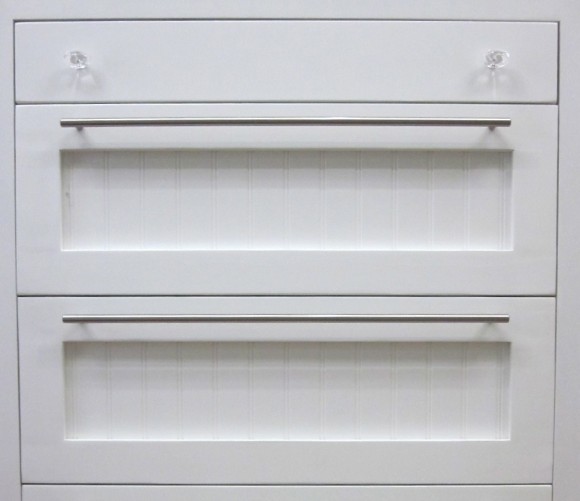
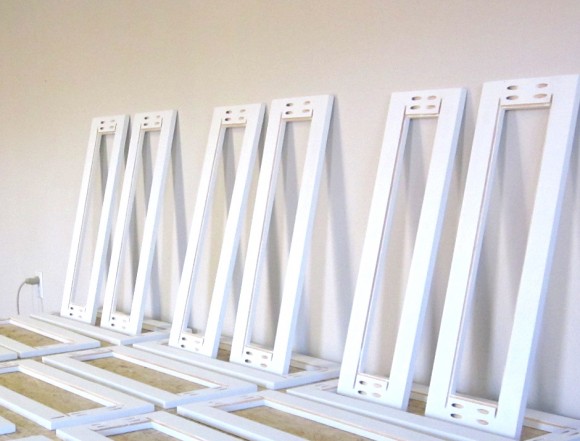
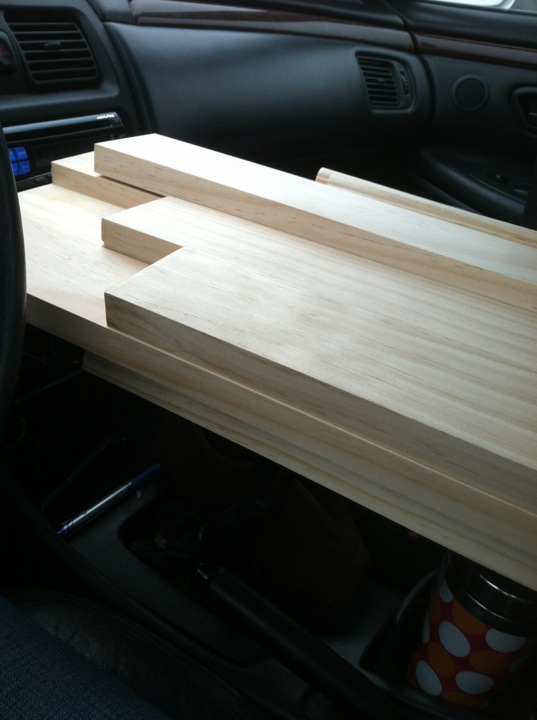
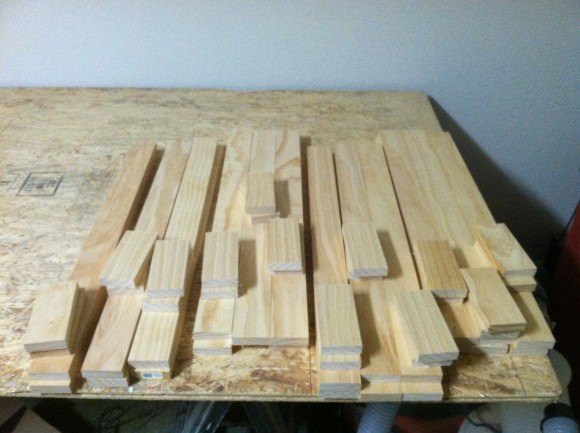
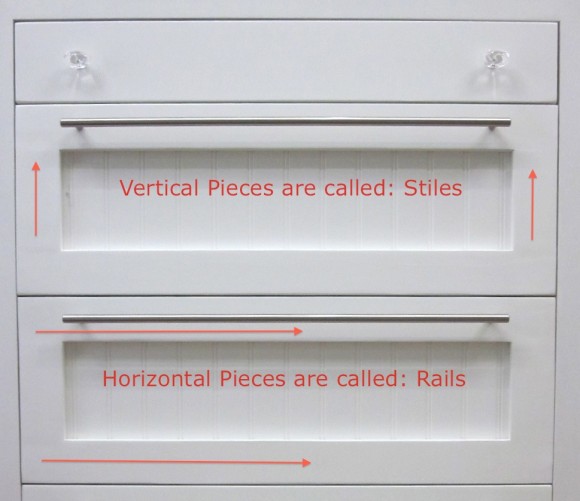
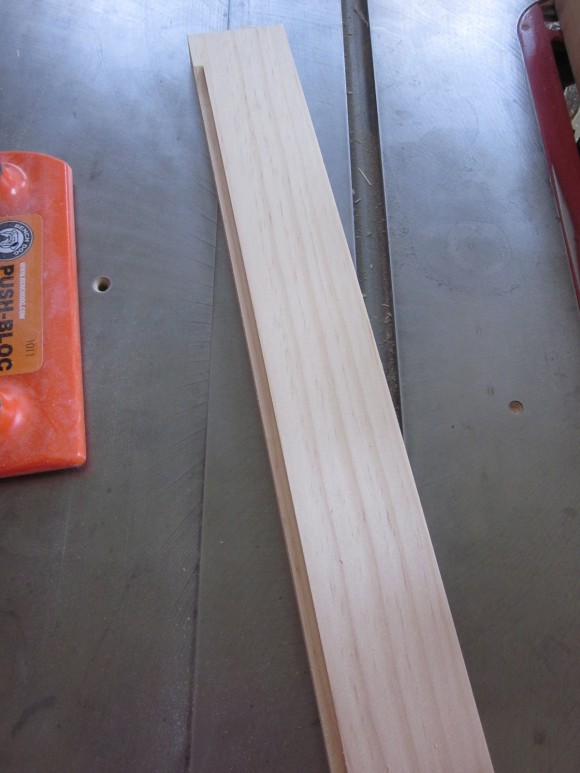

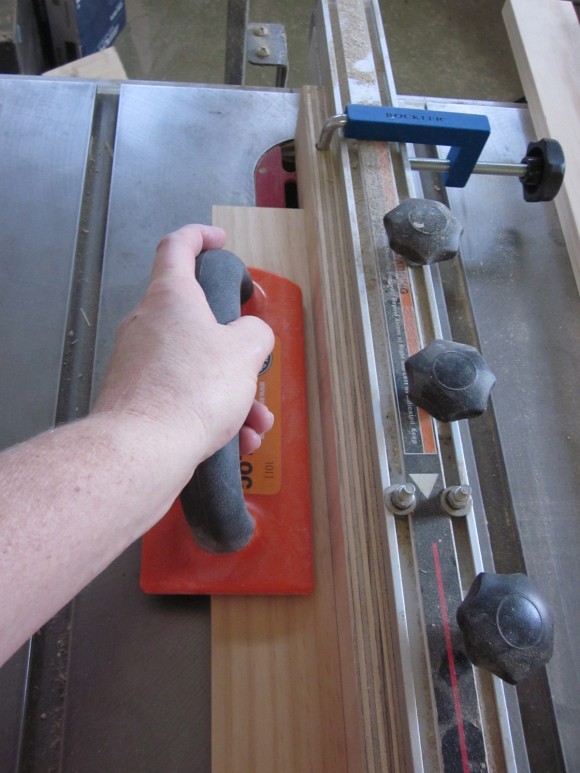
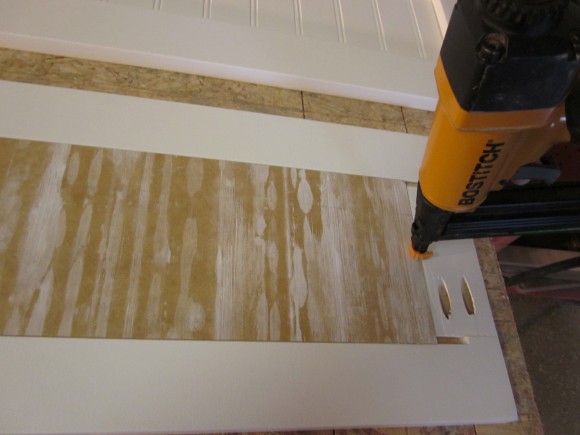
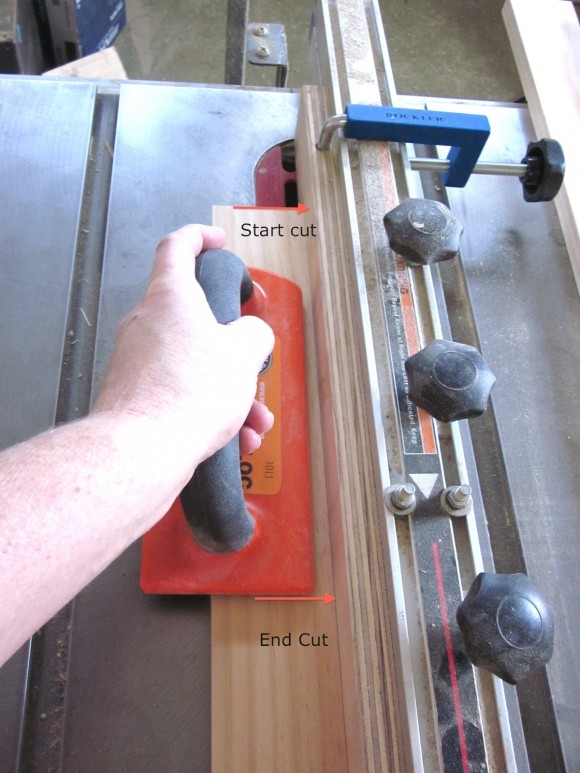

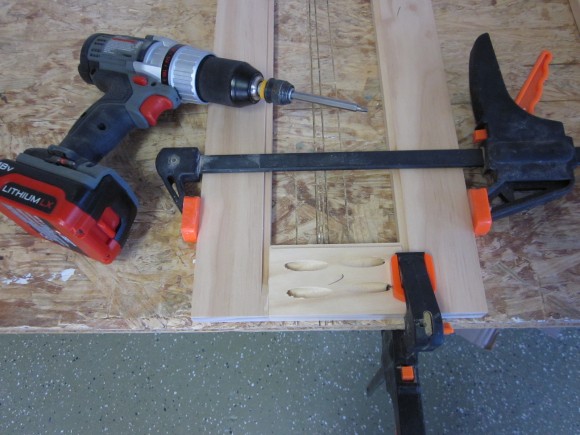



Autum says
I’m pretty sure you are younger than me, but can I just say, I want to be you when I grow up. I’m pretty handy when it comes to DIY, but you are a super woman!
I pinned this, not because I have delusions that I will be able to make my own drawers, but you can bet I am going to convince my husband there is no reason he can’t armed with such detailed instructions. Thank you!
Katy says
that little plastic tool that is clamped down to drill the pocket holes – does that have a name? (The blue thingie) Is that part you meant you misplaced?
That seems like an important tool in this process. I still haven’t jumped into cabinet building but I might be getting closer. lol
Sandra says
That entire blue thing is a pocket hole jig. It has different ends that you change out depending on the thickness of the material you are using. I meant to do a little tutorial on how to use the pocket hole jig BEFORE I posted this but my post for today had to be pulled last night because of “behind the scene issues” so I just posted this baby. I will try to post the pocket hole tutorial on Monday as I originally planned. Completely BassAckwards but that’s how I do things around here! 🙂
Tracy says
My new painted black cabinets are going to be AWESOME! I will send you pics when they are done….the granite will be in next week. The cabinets will be finished in about 3 days I think-the paint is taking a long time to dry since it’s cold/winter.
Maureen says
Sandra,
How did you attach the fronts to the drawers? Did you simply screw them on or use the pocket hole jig again? If screws – did you counter sink them and fill in holes and paint or if pocket hole jig and fill in bigger holes and paint? Is one type of attachment stronger than the other? If making these drawer fronts for something that will get a lot of strenuous use, such as a kitchen cabinet, are screws sufficient or a lazy man’s way of doing things? Do the attachments show in the drawer backs? Are the drawer pulls attached to just the face fronts or do they connect to the drawer itself? Damn, how I wished we lived close enough that I could come over and see personally! I hope you don’t mind all the questions; I’m very curious and like I said before I have next to no knowledge on this type of skill.
Maureen
Sandra says
Maureen I love your curiosity and enthusiasm! Attaching the drawer fronts is tedious especially in a run with no face frame between them (like I have in this closet). It’s straight forward but getting everything lined up and evenly spaced requires precision and that means tons of tiny adjustments. It’s a whole additional post. As soon as I get my workshop drawers built, (hopefully today but no promises), I’ll show you how I do it. (And I’ll be sure to look at all your questions again so I can answer them. It will be easier to “show and tell” than to explain.
Karen @ www.feralturtle.com says
I love love love your closet. I show everybody that comes over. I have pinned it, drooled over it, dreamed about it, and am someday, going to build my own, but on a smaller scale. (Lack of space) Thankyou for all the inspiring posts on your closet. You are so greatly appreciated from this turtle!
Chantelle - ThousandSquareFeet says
Fantastic! Oh, with each of these posts, I really think I may build the next kitchen! Now, one small typo (but it confused me greatly!) – in your explanation of rails and stiles, you say the exact opposite thing. In the typing, you say “Rails are vertical pieces, stiles are horizontal. It’s easy to remember if you think of a hand RAIL (which is horizontal)!” and then in the photo you say rails are horizontal and stiles are vertical. I think the photo is correct? And I would also love to know how you attached the drawer fronts but I think you said you would get to that so I will wait!
Sandra says
Good Grief I amaze myself! The labeled picture is correct and I’ve fixed the post. Thank you for pointing that out. Oi! I will do a tute (maybe video) for attaching. It’s tedious (but not rocket science) and better to see than to read, I think.
Jaime says
Sandra very informative and so useful. It still amazes me how you get the drawer fronts to fit in your cabinet so precisely, there must be about 1/16 of space all around those fronts, just beautiful work.
Ann Rourke says
I am one of your non-blogger nor HER girls…just an avid reader. I had a few project to send pictures of but not sure of the e-mail address to send to? It doesn’t allow pictures to be sent to sawdustgirl.com? Is there another way?
Sincerely,
Ann Rourke
Gary says
Hi, what exactly is that “beadboard panel”? Is that some sort of sheet material or lining boards?
Thanks in advance.
Gary
Airin says
What kind of table saw do you own? I have many tools, but I am limited in my projects because I don’t own a table saw. Please advise.
Julie Peterson says
YOU ROCK!!!! This tutorial is AWESOME and I am going to do this. I don’t know where, but gonna find someplace to build drawers:)
thanks
julie
Monika says
Hi! Maybe I missed it but how much “overhang” do you have around the drawer.. I guess what I’m asking is is the drawer front the same size as the front of the drawer? It seems on the finished pics that maybe it about .25″ larger all around, no? Also, I cannot find your post on how to build dadoed drawers.
Sandra says
These are inset drawer fronts. They fit inside the faceframe. You can make the overlay as wide as you want but I generally match the drawer overhang to the door overhang and that depends on what hinges you buy. 1/2″ overlay is probably the easiest because you don’t have to be so precise.
Daniel says
You do rock – really enjoyed the instructions and the video! I’m building a window seat for my daughters bedroom, and was getting hung up on the drawer fronts. Tried to cut a groove for the panels to float in but ended up making some scrap lumber! I like your method using pocket screws and a much simpler rabbet for the panels to sit in. I’m gonna give that a try.
I’m also going to show my daughters your website – I want them to see that women can be great carpenters!
Thanks,
Daniel
Sandra says
I’m so glad this tutorial was helpful Daniel and SO glad you are encouraging your daughters! I think us girls can do just about anything. 😉
(p.s. I’d love to see pictures of your project. I may pester you for a year if you don’t send me some so better just do it! LOL)
Allison Jabaay says
I found your blog on pinterest awhile ago, and I decided to try your drawer front tutorial to update our vanity. I just made them as part of a “I pinned it, I did it” challenge, and I love the results! I just wanted to stop by to say thanks for the great tutorial and making it so easy for me to do this. I think I’m addicted to building things now.
I just put up pictures of the finished product if you want to check it out.
http://jabaayave.wordpress.com/2013/02/27/i-pinned-it-i-did-it-nautical-bathroom-upgrades/
Thanks!
Abdul says
Hi Sandra,
What’s the length of your stiles & rails?
Abdul.
Adriana Planes says
These are beautiful. Have been looking online for “how to build beadboard drawer and cabinet door” tutorials. This is by far the best one I’ve found. Very specific details, great and clear explanations! My one question would be, how would you do the back part of a cabinet door rather than a drawer; you said you didn’t recommend pocket holes for doors. What do you recommend? Thanks so much!
Sandra says
Thanks Adriana. I have a cabinet door tutorial too. Here: http://sawdustgirl.com/2013/03/18/how-to-build-inset-doors-with-beadlock-mortise-and-tenons/
Gil says
OK !…This is what I was looking for, I guess I was too premature when I said I didn’t see these instructions for the drawer fronts. Thank you for such detailed and complete instructions. You make everything seem so easy. Beautiful work, it doesn’t get any better!
Emmah Mthembu says
First of all i must say that you are one talented lady. l love your work. You make it look so easy. i came across your work on youtube and came straight to this site and i have been on it all day. I had a quick question. after you put together the frames for the drawers fronts before you painted them, i can see the seams of where you joined them but they completely disappear when you are done. how did you do that? did you use a filler and then sand?